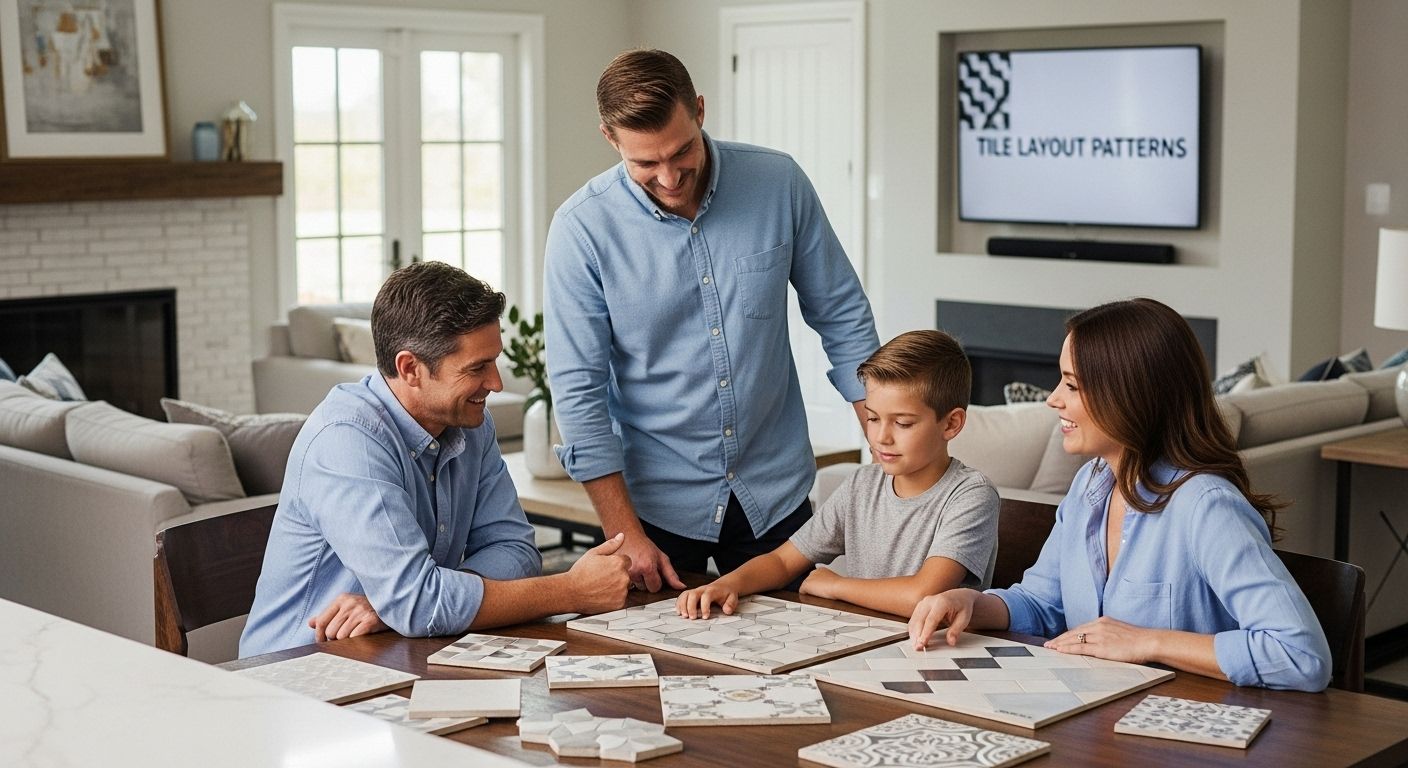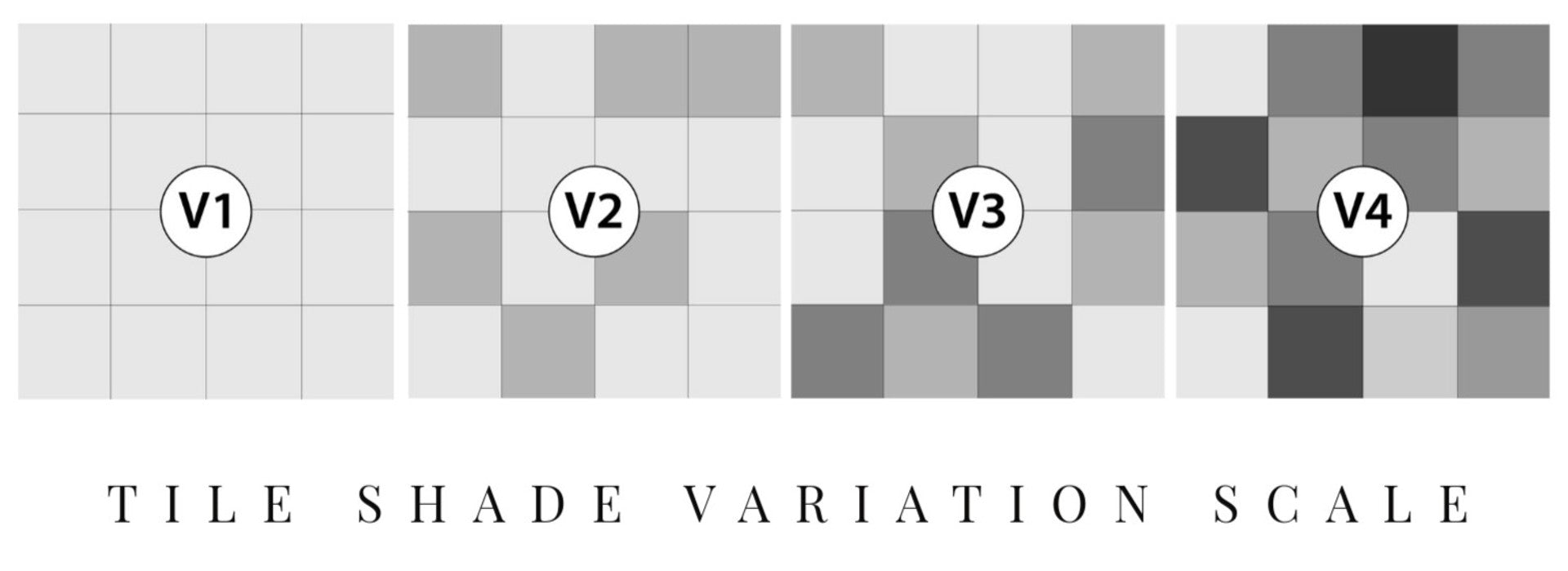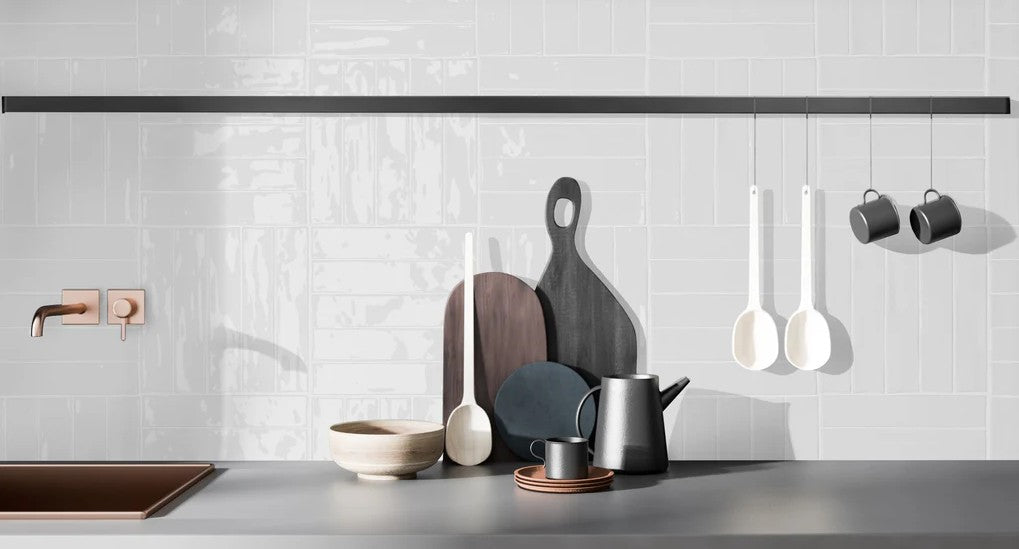Tile layout patterns might sound like just another design choice, but these arrangements do way more than cover your floors or walls. Some patterns can actually make a room look twice as big, while others subtly guide your eye and even alter how you feel in a space. The real surprise is that these designs are governed by mathematical rules that shape how our brains respond to symmetry and complexity. This hidden science reveals why the right tile pattern can completely transform any room without you even realizing it.

Table of Contents
- What Are Tile Layout Patterns And Their Importance?
- The Aesthetics Of Tile Layout Patterns In Interior Design
- Functional Aspects Of Tile Layout Patterns In Different Spaces
- Choosing The Right Tile Layout Pattern For Your Project
Quick Summary
| Takeaway | Explanation |
|---|---|
| Tile patterns enhance design aesthetics | Thoughtful tile arrangements create visual interest and define spatial dynamics, transforming ordinary surfaces into impactful design elements. |
| Mathematical principles inform tile layouts | Designers use geometric relationships and symmetry to create patterns that are both visually appealing and structurally sound. |
| Consider spatial requirements for functionality | Different areas, like high traffic zones, require specific patterns for optimal functionality, safety, and performance. |
| Pattern selection affects emotional response | Tile arrangements can evoke different feelings, influencing viewer perceptions and the overall atmosphere of a space. |
| Strategize based on design context | Evaluate room dimensions, lighting, and intended use to choose the most suitable tile pattern for your project. |
What are Tile Layout Patterns and Their Importance?
Tile layout patterns represent strategic arrangements of tiles that transform ordinary surfaces into visually compelling design elements. These patterns go beyond simple functional coverage, serving as a critical aesthetic tool in architectural and interior design spaces. By thoughtfully positioning tiles, designers create visual interest, define spatial dynamics, and communicate sophisticated design narratives.
Understanding the Fundamental Concept
At its core, a tile layout pattern is a systematic method of positioning tiles to create specific visual effects. These patterns can range from simple grid configurations to intricate geometric designs that challenge traditional perceptual boundaries. Each arrangement communicates different aesthetic qualities, influencing how viewers perceive space, depth, and movement.
Key characteristics of tile layout patterns include:
- Directional flow and visual movement
- Spatial perception manipulation
- Aesthetic complexity and visual rhythm
- Potential to enhance or redefine architectural spaces
Mathematical and Design Principles
Interestingly, tile layout patterns are not just artistic expressions but also mathematical constructs. As research demonstrates, these patterns involve intricate relationships between geometric shapes, symmetry, and spatial organization. Designers and architects leverage mathematical principles to create tile arrangements that are both visually stunning and structurally coherent.
Professional designers often use tile layout patterns to achieve specific design objectives. These might include creating an illusion of expanded space, directing visual attention, or establishing a particular mood within a room. By understanding the underlying principles of pattern creation, designers can transform simple tile installations into powerful design statements.
To help clarify the practical differences, the following table compares common tile layout patterns in terms of their visual effect, functional advantages, and psychological impact.
| Pattern Type | Visual Effect | Functional Benefit | Psychological Impact |
|---|---|---|---|
| Grid | Orderly, structured | Easy installation, predictable wear | Calm, balanced |
| Diagonal | Expands perceived space | Minimizes appearance of irregular walls | Dynamic, open feel |
| Herringbone | Dynamic movement, visual energy | Distributes load, hides dirt | Engaging, sophisticated |
| Asymmetrical | Contemporary, creative | Customizes space, unique flow | Energetic, stimulating |
| Mosaic/Complex | Intricate, decorative | Highlights focal areas | Artistic, expressive |
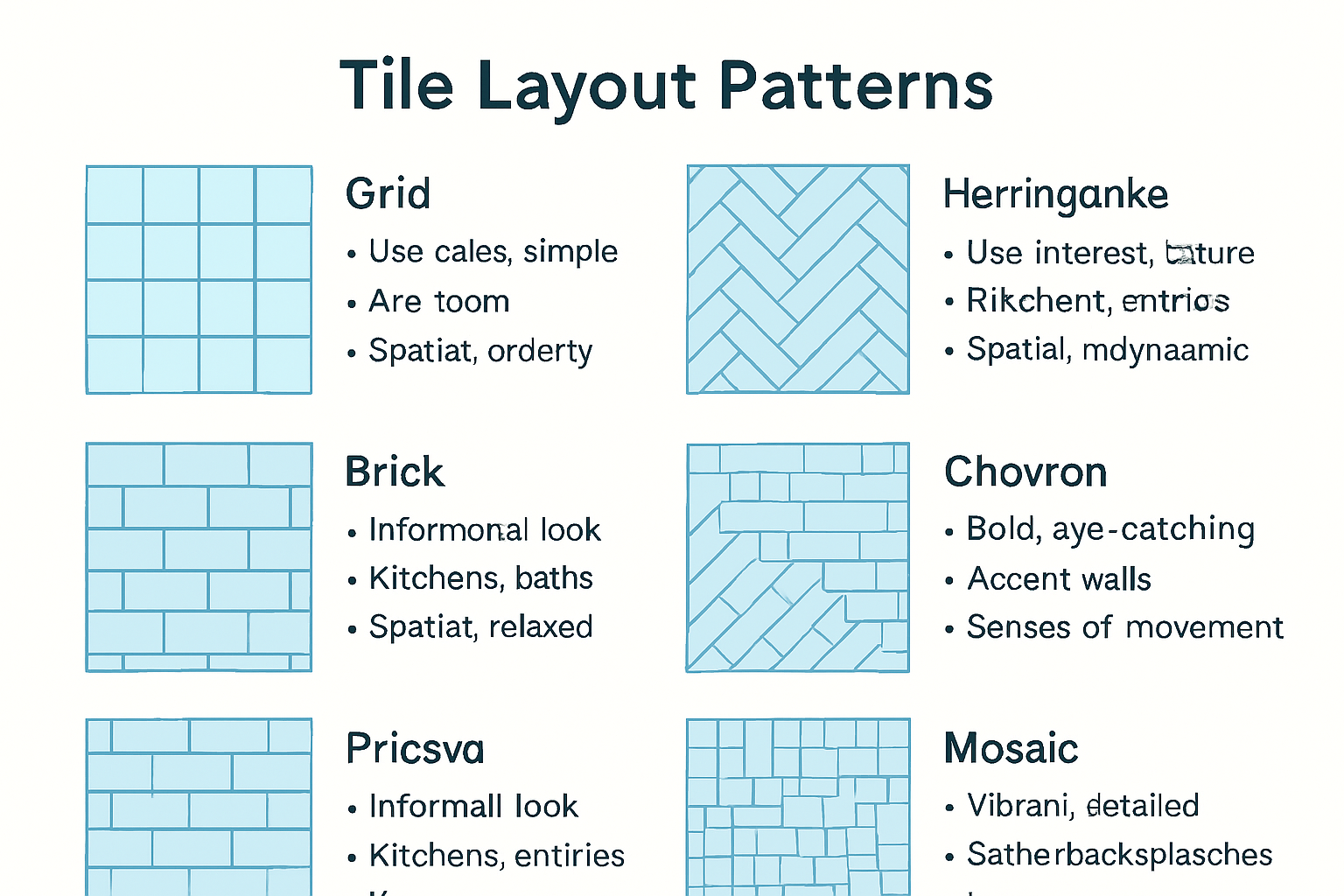
For those interested in exploring more sophisticated tile design techniques, our comprehensive tile design guide offers deeper insights into creating remarkable spatial experiences through strategic tile placement.
The Aesthetics of Tile Layout Patterns in Interior Design
Tile layout patterns represent more than geometric arrangements. They are sophisticated visual languages that communicate design intent, emotional resonance, and spatial narrative within interior environments. These intricate compositions transform surfaces from mere functional coverings into powerful aesthetic statements that engage viewers and define architectural experiences.
Visual Storytelling Through Pattern Design
Every tile layout pattern carries inherent visual communication potential. Designers strategically manipulate tile placement to evoke specific emotional responses and create unique spatial perceptions. Some patterns suggest movement and dynamism, while others communicate tranquility and order. Symmetrical arrangements might convey precision and balance, whereas asymmetrical configurations can introduce visual tension and contemporary energy.
Key aesthetic considerations in tile pattern design include:
- Perception of spatial depth and dimension
- Emotional and psychological impact of geometric arrangements
- Cultural and historical design influences
- Visual weight and balance of tile configurations
Psychological and Sensory Dimensions
Interestingly, research from the National Library of Medicine reveals that tile patterns significantly influence neural responses and aesthetic experiences. The human brain processes geometric arrangements subconsciously, responding to symmetry, complexity, and rhythmic elements. Professional designers leverage these psychological insights to create environments that subtly guide viewer perception and emotional engagement.
The selection of tile layout patterns becomes a nuanced art form, balancing mathematical precision with intuitive design sensibilities. By understanding how different arrangements interact with light, space, and human perception, designers craft immersive environments that transcend traditional decorative approaches.
For those seeking to explore innovative tile design possibilities, our curated tile pattern collection offers inspiration and professional insights into transformative spatial design strategies.
Functional Aspects of Tile Layout Patterns in Different Spaces
Tile layout patterns serve more than aesthetic purposes. They are strategic design solutions that address functional requirements across various architectural environments. Each space demands unique considerations, transforming tile patterns from mere decorative elements into intelligent spatial problem solvers that enhance usability, safety, and performance.
Spatial Performance and Design Optimization
Different interior spaces require specific tile layout approaches to maximize functionality. High traffic areas like commercial hallways and kitchen floors demand patterns that distribute weight evenly and minimize wear. Conversely, residential spaces might prioritize visual comfort and emotional resonance. The strategic selection of tile layout becomes a nuanced decision balancing practical performance with design intentions.
Key functional considerations in tile pattern selection include:
- Load distribution and wear resistance
- Slip prevention and safety requirements
- Maintenance and cleaning efficiency
- Acoustic and thermal performance
- Visual expansion or contraction of spatial perception
Below is a summary table highlighting key functional considerations to weigh when selecting a tile layout pattern for different spaces.
| Functional Consideration | Description |
|---|---|
| Load Distribution | How well the pattern manages weight and foot traffic |
| Slip Resistance | Ability to prevent slipping, increasing safety |
| Maintenance & Cleaning | Ease of upkeep and durability over time |
| Acoustic/Thermal Performance | Impact on noise levels and temperature regulation |
| Visual Space Modification | Pattern’s ability to enlarge or shrink perceived space |
Technical Considerations in Pattern Implementation
According to expert guidance from the National Kitchen & Bath Association, tile patterns significantly impact spatial functionality. Diagonal layouts can visually enlarge rooms, while grid patterns provide structured, predictable surfaces. Professional designers carefully analyze environmental conditions, traffic patterns, and user interactions to develop optimal tile configurations.
The complexity of functional tile design extends beyond visual aesthetics. Technical considerations like grout selection, tile material, and precise installation techniques determine long term performance. Intelligent pattern selection can mitigate potential issues such as moisture penetration, structural stress, and premature degradation.
For designers seeking advanced insights into functional tile solutions, our professional tile installation resources provide comprehensive guidance on creating resilient, high performance tile environments.
Choosing the Right Tile Layout Pattern for Your Project
Selecting the appropriate tile layout pattern is a critical decision that transcends mere aesthetic preference. It requires a comprehensive understanding of spatial dynamics, functional requirements, and design objectives. Professional designers approach pattern selection as a strategic process that balances visual impact, practical performance, and architectural context.
Evaluating Design Context and Requirements
Every tile layout pattern carries unique characteristics that interact differently with architectural spaces. Contextual analysis becomes crucial in making informed selections. Factors such as room dimensions, lighting conditions, architectural style, and intended functional use play pivotal roles in determining the most suitable pattern. Some layouts visually expand spaces, while others create intimate, structured environments.
Key considerations in pattern selection include:
- Room size and spatial proportions
- Architectural style and design narrative
- Lighting conditions and natural illumination
- Intended functional usage of the space
- Personal aesthetic preferences
Professional Pattern Selection Strategies
According to expert guidance from the National Kitchen & Bath Association, successful tile pattern selection involves multiple strategic layers. Diagonal layouts can create visual expansion, grid patterns offer structured predictability, and herringbone configurations introduce dynamic movement. Professional designers meticulously analyze environmental conditions, ensuring the chosen pattern harmonizes with the overall design ecosystem.
Technical precision plays a significant role in pattern implementation. Considerations like tile size, material properties, grout selection, and installation techniques determine the long term success of the design. Careful planning prevents potential issues such as uneven surfaces, excessive tile cuts, and structural inconsistencies.
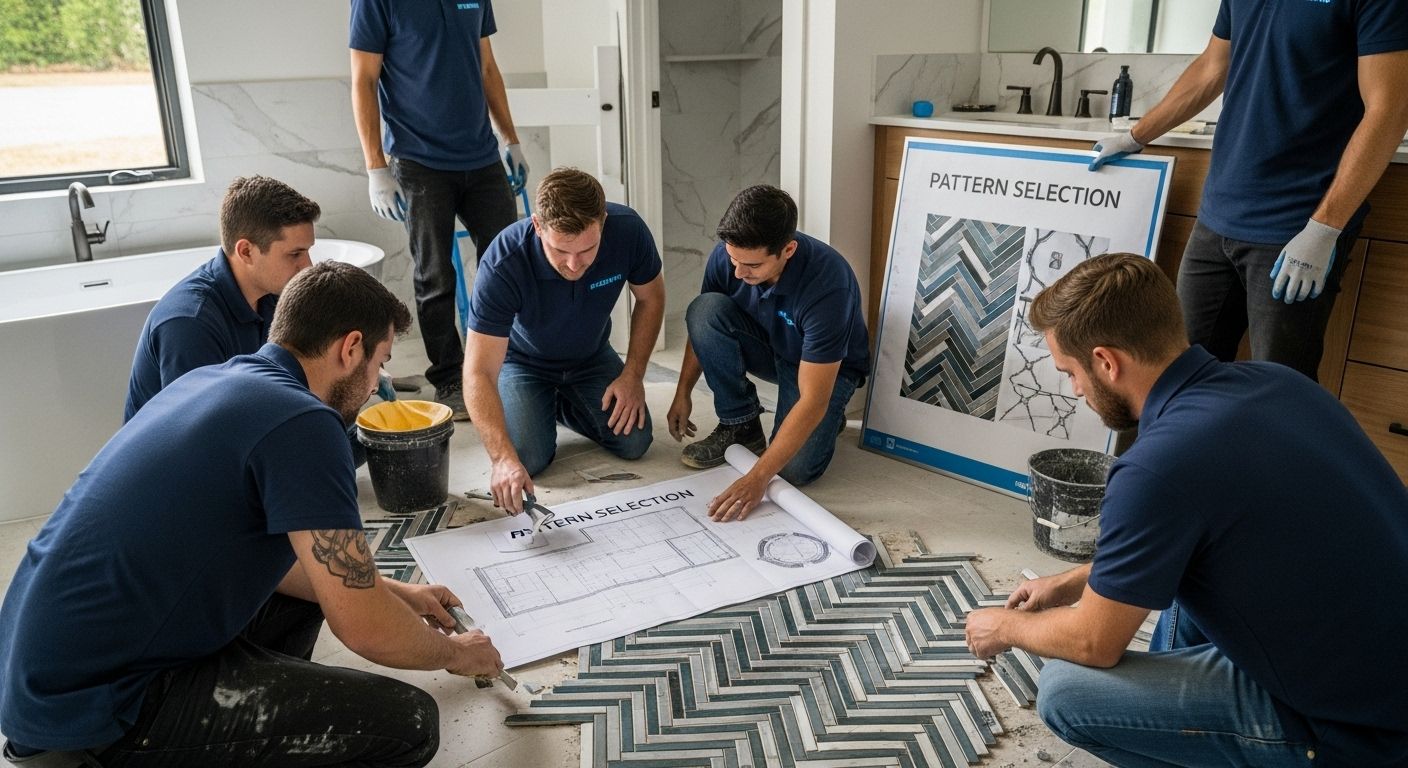
For design professionals seeking advanced guidance, our curated tile pattern selection resources offer comprehensive insights into creating sophisticated, high performance tile environments.
Bring Your Tile Layout Vision to Life With TileChoices.com
Selecting the perfect tile layout pattern can feel overwhelming. Challenges like maximizing space, deciding on the right design narrative, and balancing both function and style are real concerns. If you are struggling to make sense of intricate grid patterns, herringbone, or diagonal layouts, you are not alone. You want your living space to look beautiful and feel cohesive, but you also need reliable materials and guidance to get there.
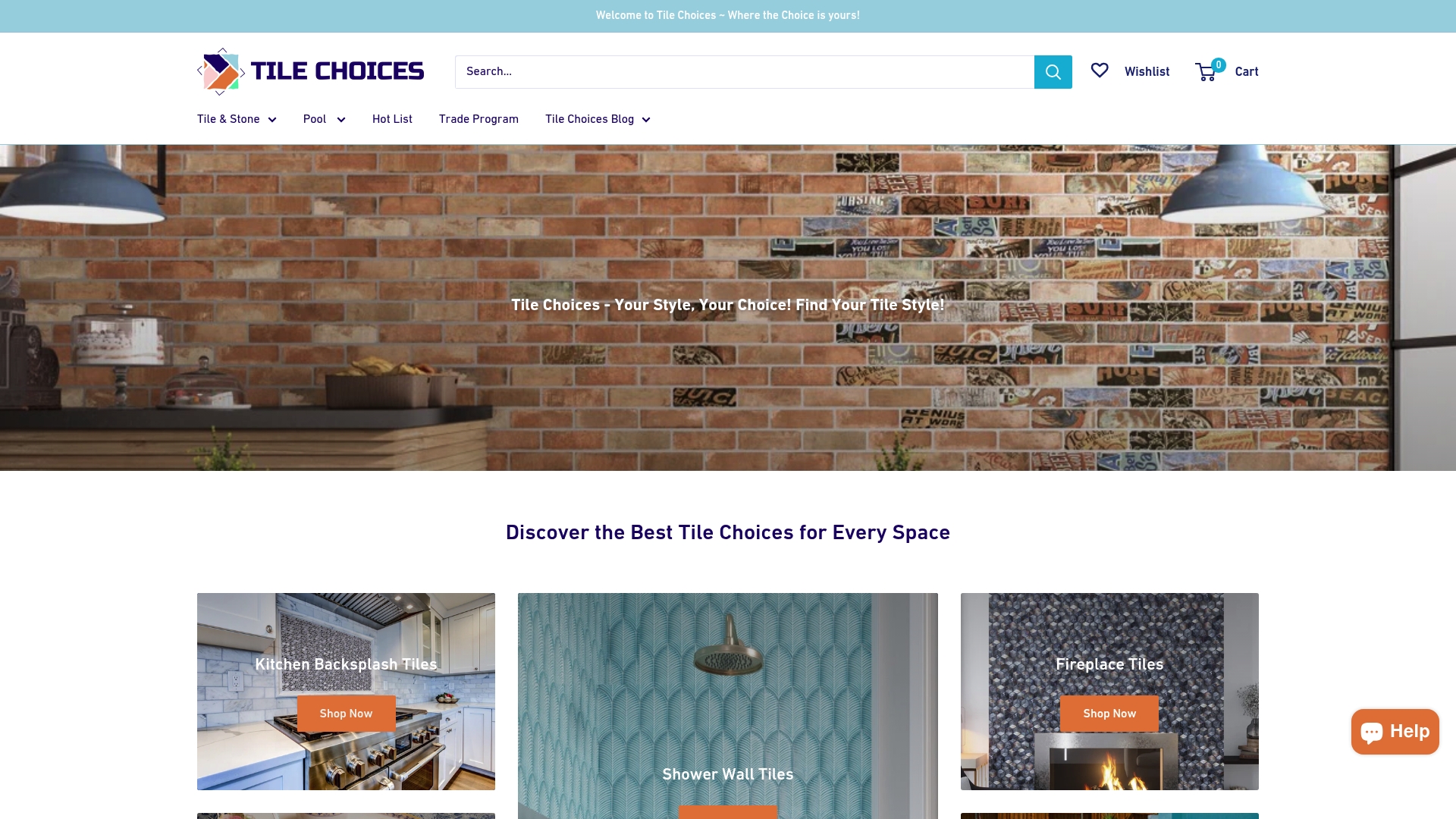
Let your design ideas take shape with confidence. At TileChoices.com, you will discover a curated selection of high-quality tiles, clear product descriptions, and inspiration that directly address the key concepts discussed in tile pattern design. Explore our tile collection and tap into our practical project planning resources for a smoother renovation journey. Make your next step toward a home transformation by visiting TileChoices.com now and start building a stylish, functional space that truly reflects your vision.
Frequently Asked Questions
What are tile layout patterns?
Tile layout patterns are strategic arrangements of tiles designed to enhance the aesthetic and functional qualities of a space. They can range from simple grids to intricate designs that influence perception and mood within an architectural environment.
How do tile layout patterns affect the perception of space?
Tile layout patterns can manipulate spatial perception by creating illusions of depth and movement. For example, diagonal layouts may make a room feel larger, while symmetrical patterns can convey balance and order.
What functional considerations should be kept in mind when choosing a tile layout pattern?
When choosing a tile layout pattern, consider factors such as load distribution, slip resistance, maintenance ease, and the overall intended use of the space. This ensures that the design remains both visually appealing and practical.
Can tile layout patterns impact the emotional experience of a room?
Yes, different tile arrangements can evoke specific emotional responses. For instance, asymmetrical configurations may introduce energy and tension, while symmetrical patterns can create a sense of tranquility and harmony.

